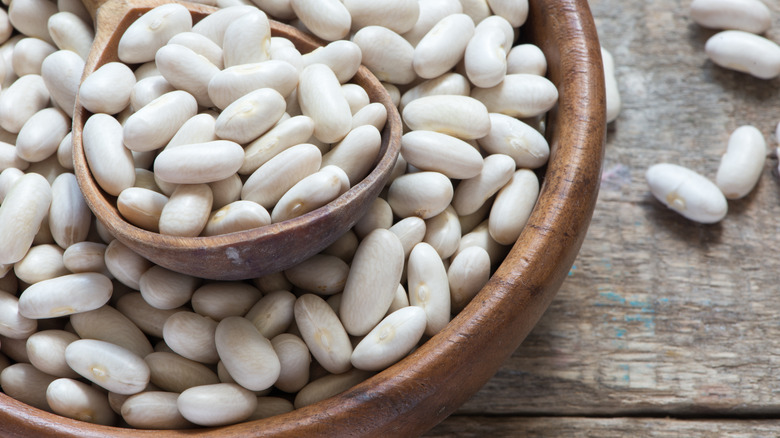The Wild Etymology Behind The Humble Cannellini Bean
Humans tend to think a lot about food — it's one of the traits that defines us as a species, crossing boundaries as an inextricable part of human culture. But one aspect of food we don't think of nearly enough is food etymology: why we call food the things we call it. Food names can seem a bit dry at first blush, however, they're anything but. It's fascinating to know the etymology of "calzone" comes from them being designed to be carried around in one's pants, or that casserole's etymology originally comes from a Greek word meaning "little cup."
Cannellini beans, though, might have them all beat for the length of their linguistic journey. Their long etymological sojourn ends in Peru — where they're native — but goes back from there to Argentina to Italy to Southeast Asia to the Roman Empire, all the way back to an extinct Mesopotamian language called Akkadian. Somehow, this makes perfect sense when you examine it step by step.
Cinnamon is key to the linguistic journey
All beans are native to the Americas, which is why indigenous Americans often referred to them as one of the "three sisters" of plants along with squash and corn. Cannellini beans specifically originally came from Peru before spreading to the rest of South America. Their modern name, though, came from Europeans, who first encountered them in large amounts in the late 19th century, when millions of Italians emigrated to nearby Argentina, where the beans had spread. These immigrants looked at the beans and decided they looked like the candy they were already calling "cannellini." They began calling them "cannellini beans," and the name stuck.
But how do we get from that endpoint — Italians in Argentina saying a bean looked like a candy — back to an ancient Mesopotamian empire? Well, first we have to go to Southeast Asia and back, for one of the most well-known spices in the world: cinnamon. Cinnamon is native to Southeast Asia, so when Italians encountered the spice for the first time, they didn't quite know what to make of it. They started calling it "cannella" because of its distinctive tube shape before being ground. They then used it to flavor a type of oblong candy they called "cannellini." But where did "cannella" come from?
The word for cinnamon has ancient roots
The roots of "cannella," unsurprisingly, are in Latin. This is where the Roman Empire — which, let's remember, started in Italy — comes in, because Rome is how Latin became the root of a ton of different modern languages. But it's the roots of Latin itself where this story ends (or begins, as it were).
Without delving too deeply into the weeds here, the Akkadian Empire was a Mesopotamian nation from around 2300 to 2200 BCE. Though their language is extinct today, it had a profound effect on later languages — including Latin. One of these was the word "qanû," meaning reed, shaft, or pipe. Eventually, "qanû" came to refer to any cylindrical object — which is what happened when it merged into Latin, becoming "canna," where it's the root word for words like "cane" and "canyon," among others, including of course cannella (cinnamon) and cannellini.
So there you have it: the etymological origin of cannellini beans, a South American bean named after an Italian candy named after a Southeast Asian spice with roots tied to ancient Mesopotamia. Now if only we could figure out the mysterious origins of the word "tequila."


